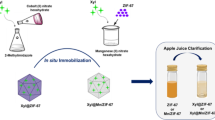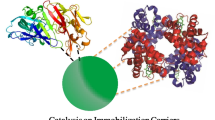Abstract
In this study, ene reductase (ER) was entrapped in polyvinyl alcohol hydrogel, adsorbed on montmorillonite and immobilized covalently on glutaraldehyde activated 3-aminopropyl-functionalized silica gel. Although protein recovery yields were at least 85% for adsorption and covalent immobilization, only the encapsulated ER showed activity. The activity of free and entrapped ER preparations was measured by following NADPH-dependent reduction of 2-cyclohexen-1-one. The both protein recovery and activity recovery yields were calculated as 100% when 1 mg protein was used for immobilization. The both free and entrapped ER preparations showed the same optimum pH and temperature as 7.0 and 30 °C, respectively. The entrapped ER showed 34.4-fold more thermal stability than that of the free ER at 30 °C. Michaelis-Menten constant and maximum velocity values were 0.25 mM and 1.2 U/mg protein, respectively for the free ER towards 2-cyclohexen-1-one. The corresponding values were 1.5 mM and 0.9 U/mg protein for the entrapped ER. The results of time-course reduction of 2-cyclohexen-1-one showed that the entrapped ER catalyzed the reaction as effectively as the free ER. The entrapped ER remained 85% of its initial activity after 10 reused cycles.








Similar content being viewed by others
Data Availability
Data will be made available on request.
References
Berenguer-Murcia A, Fernandez-Lafuente R (2010) New trends in the recycling of NAD(P)H for the design of sustainable asymmetric reductions catalyzed by dehydrogenases. Curr Org Chem 14:1000–1021
Çakar MM, Ruupunen J, Mangas-Sanchez J, Birmingham WR, Yildirim D, Turunen O, Turner NJ, Valjakka J, Binay B (2020) Engineered formate dehydrogenase from Chaetomium thermophilum, a promising enzymatic solution for biotechnical CO2 fixation. Biotechnol Lett 42:2251–2262
Younus H (2019). In: Husain Q, Ullah MF (eds) Biocatalysis: enzymatic basics and applications. Springer, Cham
Ni Y, Yu HL, Lin GQ, Xu JH (2014) An ene reductase from Clavispora lusitaniae for asymmetric reduction of activated alkenes. Enzyme Microb Technol 56:40–45
Ernst H (2002) Recent advances in industrial carotenoid synthesis. Pure Appl Chem 74:1369–1382
Szczepańska E, Colombo D, Tentori F, Olejniczak T, Brenna E, Monti D, Boratyński F (2021) Ene-reductase transformation of massoia lactone to δ-decalactone in a continuous-flow reactor. Sci Rep 11:18794
Kumar Roy T, Sreedharan R, Ghosh P, Gandhi T, Maiti D (2022) Ene-reductase: a multifaceted biocatalyst in organic synthesis. Chem-Eur J 28:e202103949
Toogood HS, Scrutton NS (2018) Discovery, characterization, engineering, and applications of ene-reductases for industrial biocatalysis. ACS Catal 8:3532–3549
Nett N, Duewel S, Schmermund L, Benary GE, Ranaghan K, Mulholland A, Opperman DJ, Hoebenreich S (2021) A robust and stereocomplementary panel of ene-reductase variants for gram-scale asymmetric hydrogenation. Mol Catal 502:111404
Sheldon RA (2007) Enzyme immobilization: the quest for optimum performance. Adv Synth Catal 349:1289–1307
Garcia-Galan C, Berenguer-Murcia Á, Fernandez-Lafuente R, Rodrigues RC (2011) Potential of different enzyme immobilization strategies to improve enzyme performance. Adv Synth Catal 353:2885–2904
Yildirim D, Alagöz D, Toprak A, Tükel S, Fernandez-Lafuente R (2019) Tuning dimeric formate dehydrogenases reduction/oxidation activities by immobilization. Process Biochem 85:97–105
Alagöz D, Toprak A, Yildirim D, Tükel SS, Fernandez-Lafuente R (2021) Modified silicates and carbon nanotubes for immobilization of lipase from Rhizomucor miehei: effect of support and immobilization technique on the catalytic performance of the immobilized biocatalysts. Enzyme Microb Technol 144:109739
Nagy F, Gyujto I, Tasnádi G, Barna B, Balogh-Weiser D, Faber K, Poppe L, Hall M (2020) Design and application of a bi-functional redox biocatalyst through covalent co-immobilization of ene-reductase and glucose dehydrogenase. J Biotechnol 323:246–253
Li H, Xiao W, Xie P, Zheng L (2018) Co-immobilization of enoate reductase with a cofactor-recycling partner enzyme. Enzyme Microb Technol 109:66–73
Tentori F, Bavaro T, Brenna E, Colombo D, Monti D, Semproli R, Ubiali D (2020) Immobilization of old yellow enzymes via covalent or coordination bonds. Catalysts 10:260
Zanker AA, Ahmad N, Son TH, Schwaminger SP, Berensmeier S (2021) Selective ene-reductase immobilization to magnetic nanoparticles through a novel affinity tag. Biotechnol J 16:2000366
Rebroš M, Pilniková A, ŠImčíková D, Weignerová L, Stloukal R, Křen V, Rosenberg M (2013) Recombinant α-L-rhamnosidase of Aspergillus terreus immobilization in polyvinylalcohol hydrogel and its application in rutin derhamnosylation. Biocatal Biotransform 31:329–334
Ozdemir Babavatan E, Yildirim D, Peksel A, Binay B (2020) Immobilization of Rhizomucor miehei lipase onto montmorillonite K-10 and polyvinyl alcohol gel. Biocatal Biotransform 38:274–282
Toprak A, Tükel SS, Yildirim D (2021) Stabilization of multimeric nitrilase via different immobilization techniques for hydrolysis of acrylonitrile to acrylic acid. Biocatal Biotransform 39:221–231
Cerreti M, Markošová K, Esti M, Rosenberg M, Rebroš M (2017) Immobilisation of pectinases into PVA gel for fruit juice application. Int J Food Sci Technol 52:531–539
Sanjay G, Sugunan S (2006) Enhanced pH and thermal stabilities of invertase immobilized on montmorillonite K-10. Food Chem 94:573–579
Alagöz D, Tükel SS, Yildirim D (2016) Immobilization of pectinase on silica-based supports: Impacts of particle size and spacer arm on the activity. Int J Biol Macromol 87:426–432
Barbosa O, Ortiz C, Berenguer-Murcia Á, Torres R, Rodrigues RC, Fernandez-Lafuente R (2014) Glutaraldehyde in bio-catalysts design: a useful crosslinker and a versatile tool in enzyme immobilization. RSC Adv 4:1583–1600
Alagöz D, Varan NE, Toprak A, Yildirim D, Tukel SS, Fernandez-Lafuente R (2022) Immobilization of xylanase on differently functionalized silica gel supports for orange juice clarification. Process Biochem 113:270–280
Bradford MM (1976) A rapid and sensitive method for the quantitation of microgram quantities of protein utilizing the principle of protein-dye binding. Anal Biochem 72:248–254
Aregger D, Peters C, Buller RM (2020) Characterization of the novel ene reductase Ppo-Er1 from Paenibacillus Polymyxa. Catalysts 10:254
Zheng L, Lin J, Zhang B, Kuang Y, Wei D (2018) Identification of a yeast old yellow enzyme for highly enantioselective reduction of citral isomers to (R)-citronellal. Bioresour Bioprocess 5:9
Rebroš M, Rosenberg M, Mlichová Z, Krištofíková Lu, Paluch M (2006) A simple entrapment of glucoamylase into LentiKats® as an efficient catalyst for maltodextrin hydrolysis. Enzyme Microb Technol 39:800–804
Zhang X, Liao S, Cao F, Zhao L, Pei J, Tang F (2018) Cloning and characterization of enoate reductase with high β-ionone to dihydro-β-ionone bioconversion productivity. BMC Biotechnol 18:26
Peters C, Frasson D, Sievers M, Buller R (2019) Novel old yellow enzyme subclasses. ChemBioChem 20:1569–1577
Richter N, Gröger H, Hummel W (2011) Asymmetric reduction of activated alkenes using an enoate reductase from Gluconobacter oxydans. Appl Microbiol Biotechnol 89:79–89
Aslan AS, Valjakka J, Ruupunen J, Yildirim D, Turner NJ, Turunen O, Binay B (2016) Chaetomium thermophilum formate dehydrogenase has high activity in the reduction of hydrogen carbonate (HCO3–) to formate. Protein Eng Des Sel 30:47–55
Sheng X, Yan M, Xu L, Wei M (2016) Identification and characterization of a novel Old Yellow Enzyme from Bacillus subtilis str.168. J Mol Catal B: Enzym 130:18–24
Robescu MS, Niero M, Loprete G, Cendron L, Bergantino E (2021) A new thermophilic ene-reductase from the filamentous anoxygenic phototrophic bacterium Chloroflexus aggregans. Microorganisms 9:953
Clay D, Winkler CK, Tasnádi G, Faber K (2014) Bioreduction and disproportionation of cyclohex-2-enone catalyzed by ene-reductase OYE-1 in ‘micro-aqueous’ organic solvents. Biotechnol Lett 36:1329–1333
Steinkellner G, Gruber CC, Pavkov-Keller T, Binter A, Steiner K, Winkler C, Łyskowski A, Schwamberger O, Oberer M, Schwab H, Faber K, Macheroux P, Gruber K (2014) Identification of promiscuous ene-reductase activity by mining structural databases using active site constellations. Nat Commun 5:4150
Chen B-S, Médici R, van der Helm MP, van Zwet Y, Gjonaj L, van der Geest R, Otten LG, Hanefeld U (2018) Rhodococcus strains as source for ene-reductase activity. Appl Microbiol Biotechnol 102:5545–5556
Li H, Cui X, Zheng L (2019) Functionalized poplar powder as a support material for immobilization of enoate reductase and a cofactor regeneration system. J Microbiol Biotechnol 29:607–616
Funding
This research was supported by the Scientific Research Unit of Cukurova University (Grant No. FBA-2017-8812).
Author information
Authors and Affiliations
Contributions
NEV and AT carried out the experiments. DY analyzed the data, planned the experiments. DA wrote the manuscript and SST supervised the experiments.
Corresponding author
Ethics declarations
Conflict of interest
All authors declare that they have no conflict of interest.
Ethical Approval
This article does not contain any studies done with human or animal participants performed by any of the authors.
Additional information
Publisher’s Note
Springer Nature remains neutral with regard to jurisdictional claims in published maps and institutional affiliations.
Rights and permissions
About this article
Cite this article
Alagöz, D., Varan, N.E., Toprak, A. et al. Immobilization of Ene Reductase in Polyvinyl Alcohol Hydrogel. Protein J 41, 394–402 (2022). https://doi.org/10.1007/s10930-022-10059-4
Accepted:
Published:
Issue Date:
DOI: https://doi.org/10.1007/s10930-022-10059-4




